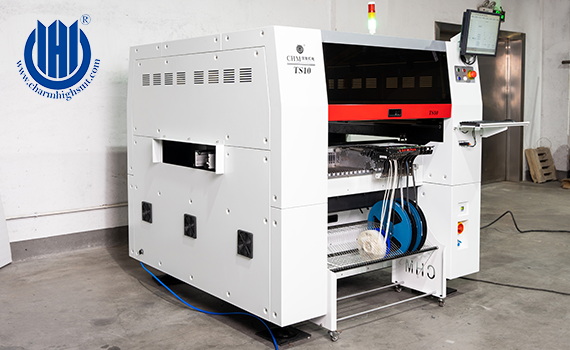Understanding 42,000 CPH Pick and Place Machine Capabilities
Defining True CPH vs. Marketing Claims
The key thing to remember when looking at pick and place machines is knowing the gap between real cycles per hour (CPH) and what manufacturers put on their brochures. Real CPH shows how fast a machine actually works during normal operation, including all the steps from picking up components to placing them correctly. Marketing departments tend to stretch the truth though, making their machines look faster than they really are just to win contracts. What happens in practice varies a lot depending on things like how well the machine is set up and how complicated the circuit boards being assembled are. Take those flashy claims about hitting 50,000 CPH for example. Most plants find themselves lucky if they get around 12,000 CPH after accounting for everything that goes on in real production environments. Smart manufacturers know this gap exists and always ask for proof of performance instead of believing the glossy spec sheets.
The Role of IPC-9850A in Standardizing Measurements
IPC-9850A is really important for folks working in electronics manufacturing because it sets consistent ways to measure component placement per hour (CPH) across different companies. The standard basically makes sure that machines do more than just grab parts they actually need to put those components correctly onto circuit boards too. When manufacturers follow IPC-9850A guidelines, everyone gets a fair way to look at how good different pick and place machines really are without companies exaggerating their specs. Sticking to this standard changes how people evaluate machine performance and what they buy, forcing manufacturers to be honest about their equipment's capabilities. As a result, buyers end up picking better performing machines which affects everything from buying decisions to how well factories run day to day operations.
Core Challenges in High-Speed SMT Assembly
Component Placement Accuracy Tradeoffs
Balancing speed against precision remains one of the toughest nuts to crack in high speed SMT assembly lines. Machines are designed to place components at lightning fast speeds, but this rush often leads to problems like misplaced parts or components shifting after placement on printed circuit boards. When these kinds of errors happen, they really mess up the whole production run. Factories end up dealing with way more rework and scrapped boards than planned, which eats into their bottom line pretty badly. Industry data points to an obvious tradeoff here - push the machines too hard and accuracy starts dropping off a cliff. That's why smart manufacturers spend time figuring out where exactly to draw the line between going fast enough to meet demand while still keeping those pesky placement errors under control. Getting this right means the difference between profitable operations and constant headaches over defective products.
Feeder Synchronization Limitations
Getting feeders properly synced remains a major headache for anyone working with SMT assembly lines. When things aren't aligned right or timing gets off track, it slows everything down and causes those dreaded production holdups. Take what happened at a plant last month where just a minor misalignment in one feeder brought the whole line grinding to a stop for over three hours straight. Deadlines went flying out the window and profits took a hit too. On the flip side, there's also that company across town which invested in some serious synchronization tech upgrades. Their operators report much smoother running machines now, with way fewer interruptions throughout shifts. The bottom line? Getting those feeders timed correctly isn't just about keeping equipment happy it directly affects whether factories meet their targets or end up scrambling to catch up later.
Gang Picking vs. Single-Component Throughput
Manufacturers thinking about how to place components on circuit boards typically look at two main approaches: gang picking versus single component placement. With gang picking, several parts get picked at once, which works really well for big batch runs since it cuts down on how many times machines need to move around, making things go faster overall. On the flip side, single component throughput gives more room for adjustments and precision work, especially important when dealing with small boards that have complicated layouts. For products where the same part gets used over and over again across multiple units, gang picking makes sense most of the time. But if there's a lot of variation in what needs placing or if tolerances are tight, then going with individual component placement becomes necessary. Most experienced folks in the field will tell anyone listening that choosing between these methods depends heavily on what exactly the factory is trying to accomplish and what kind of end product they're aiming for in terms of quality and quantity.
Optimizing Pick and Place Automation for Peak Performance
Nozzle Configuration Strategies
Looking at different nozzle setups makes a real difference when it comes to getting better results from pick and place machines. The type of nozzle used affects how well the machine picks up parts, so picking the right one matters a lot for overall efficiency. Take for example, when machines have nozzles adjusted just right for particular part sizes, they tend to experience fewer stoppages and run much smoother during operation. Most experienced technicians recommend matching nozzle choices to both component dimensions and materials, plus making sure those vacuum systems work properly for grabbing and releasing parts. Getting this stuff right actually impacts production speed quite a bit. Some factories report seeing production jumps around 20% after tweaking their nozzle arrangements, which explains why so many manufacturers spend time fine tuning these details in their automated lines.
Board Layout Optimization Techniques
Getting the board layout right makes a big difference in how fast pick and place machines work, which boosts SMT efficiency across the board. When manufacturers arrange components thoughtfully, they cut down on how far machines need to move around the board, slashing cycle times. Smart layouts typically put frequently used components closer to the edges where loading happens faster. Designers should group components according to when they get assembled and keep related parts close together whenever possible. These simple changes speed up the pick and place operation while cutting down mistakes during SMT processing. Real world data backs this up too. One factory reported cutting their cycle times by about 15% after implementing better board layouts, proving that good design decisions pay off in both time savings and fewer production errors.
Real-Time Machine Calibration Protocols
Keeping pick and place machines properly calibrated in real time matters a lot for their accuracy and overall performance on the factory floor. Good calibration routines let these machines handle different component sizes and adjust to changes in temperature or humidity that happen during regular operations. The process usually means checking things like gripper alignment, vacuum pressure levels, and software parameters at set intervals throughout shifts. Take one electronics manufacturer we worked with last year who started doing live calibrations every morning before production began. They saw around 25 percent fewer mistakes happening on their assembly lines after making this change. For companies running surface mount technology (SMT) lines where speed is everything, getting calibration right means better product quality across the board while also cutting down on scrap materials and saving money in the long run.
Future-Proofing Your SMT Manufacturing Line
Integration with Smart Factory Systems
When pick and place automation gets integrated into Smart Factory setups, it completely changes how manufacturing works today. These factories rely on internet connected devices and instant data analysis so machines can talk to each other without any problems. The result? Machines start figuring out when something goes wrong all by themselves and make adjustments on the fly. This cuts down on those frustrating production stoppages and makes everything run smoother. Take automotive parts makers for example many report around 30% better output after switching to these intelligent systems. They can now react much faster when customer orders change and keep their supply chains running at peak performance most of the time.
Upgrading Legacy Machines for Modern Standards
Modernizing old SMT machines to meet today's tech requirements isn't just nice to have anymore. Companies need to upgrade these systems if they want to stay competitive. Upgrades typically mean installing updated software packages along with newer hardware components that boost how well the machines work while making them last longer too. One big headache during this transition is dealing with all the time lost when machines are offline. But smart businesses tackle this problem through staged rollouts and careful planning around regular maintenance windows. Looking at what's happening across the industry, most manufacturers find that spending money on these improvements pays off handsomely. After getting their equipment upgraded, plenty of firms see better profits because parts break down less often and products get made faster. Getting older machinery up to speed with current specs does more than fix present issues though. It actually sets the stage for easier adoption of advanced automation technologies down the road without having to replace everything from scratch.

